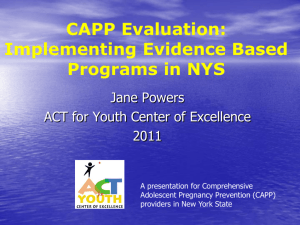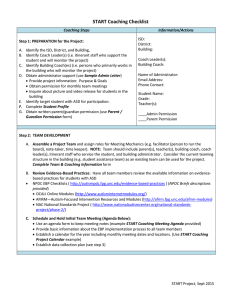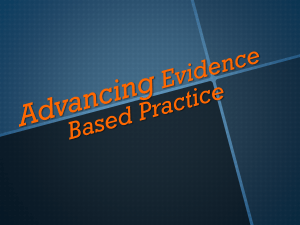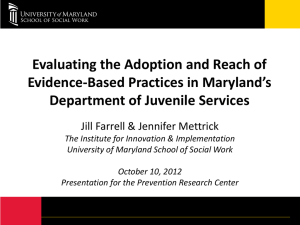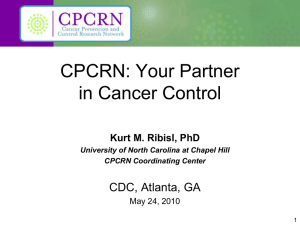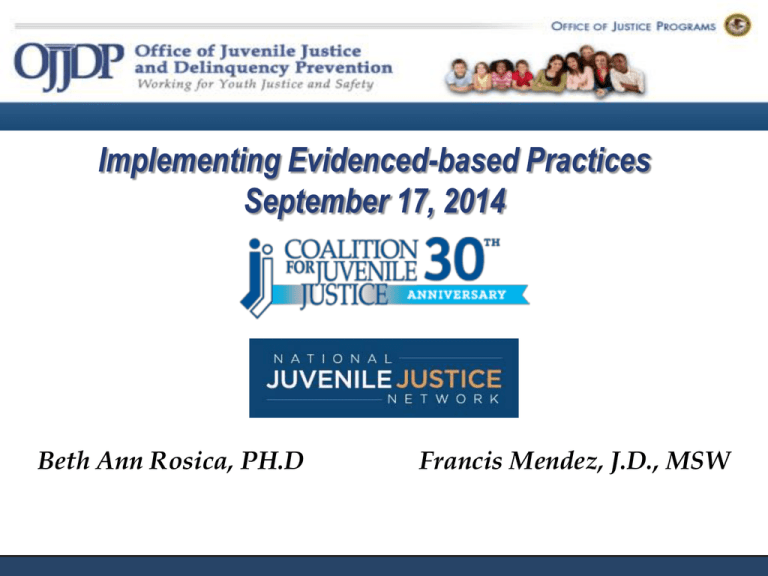
Implementing Evidenced-based Practices
September 17, 2014
Beth Ann Rosica, PH.D
Francis Mendez, J.D., MSW
About Us
VisionQuest ( www.vq.com) has over 40
years of experience delivering highly
successful innovative programs to at-risk and
juvenile youth. Over the last 10 years,
VisionQuest has made a commitment to
evidence-based practices, and all programs
utilize at least evidence-based model.
Advancing Evidence Based Practice
(www.advancingebp.org) is a nonprofit
association working to promote evidencebased programs for at-risk youth.
NTTAC ( www.nttac.org) is a central
source for accessing the Office of
Juvenile Justice and Delinquency
Prevention’s (OJJDP) Training and
Technical Assistance (TTA) resources;
serves as a one-stop shop for
requesting the full array of TTA
services offered by OJJDP; and
supports the OJJDP TTA Network
through trainings and leveraging of
virtual TTA.
How to Identify EBPs?
•
•
•
•
Blueprints for Healthy Youth Development
WSIPP
Coalition for Evidence Based Policy
CrimeSolutions.gov/Model Programs
Guide
Best Proven Model Programs*
• Brief Alcohol Screening and Intervention for College Students
(BASICS)
• Functional Family Therapy (FFT)
• LifeSkills Training (LST)
• Multidimensional Treatment Foster Care (MTFC)
• Multisystemic Therapy - Problem Sexual Behavior (MST-PSB)
• Multisystemic Therapy® (MST®)
• New Beginnings (Intervention for children of divorce)
• Nurse-Family Partnership
• Positive Action
• Project Towards No Drug Abuse
• Promoting Alternative Thinking Strategies (PATHS)
*Blueprints Model Programs
Advantages of Proven EBPs
• Reduced crime
• Reduced cost to
taxpayers
• Save lives
• Training, Manuals, QA
EBP Implementation: Getting Customer Buy-In
• Convincing stakeholders of the value and benefits of
implementing EBPs- Moving from WHY to HOW.
• Leveraging existing resources as a strategy to
introduce EBPs.
• Navigating concerns that EBP implementation
comes at the expense of local grass roots programs.
• Overcoming obstacles when there is a disconnect
between the state and local jurisdictions.
EBP Implementation: Facing Agency Challenges
• The Adoption of EBPs is challenge for providers, especially
large agencies
• Requires commitment from the highest levels of management
and a philosophical change within the agency
• Many staff are often threatened as they see their approach as
the best
• Human Services professionals are often reluctant to trust
research
• The process requires education, re-education and continual
reassurances to staff that EBPs are the right thing to do
• Implementing EBPs costs more money than traditional
services/programs
• Family Engagement can be a challenge
EBP Implementation: Key Drivers
Components that need to be present to successfully
implement evidence-based practices and programs:
Competency Drivers (Staff selection, Pre-service
and in-service training, Ongoing consultation and
coaching & Staff and program evaluation)
Organization Drivers (Facilitative administrative
support, Systems interventions & Decision Support
Data System)
Leadership Drivers (Technical & Adaptive)
Source: National Implementation Research Network
EBP Implementation: Embedding EBPs in a
Juvenile Justice Agency
• Launch EBPs as a collaborative effort with
ownership by the Agency.
• Establish a data collection framework.
• Integrate EBP referrals into objective decisionmaking.
• Jointly address referral and engagement issues.
• Establish formal communication protocols at the
case level and system level.
Referral & Engagement Issues: Data Collection
•
•
•
•
•
•
•
•
Family lives out of service
area
Youth is a sex offender
Youth is too aggressive
Youth refused treatment
Incomplete referral packet
Youth not age appropriate
AWOL
Youth has unmanageable
psychiatric Issues
•
•
•
•
•
•
Other
Referral or funding
source rescinded
Already received
EBP services
Youth placed out of
home/detained
Parents
unwilling/unavaila
ble
No slots available
Data Collection Example
Youth has unmanageable medical issues
English is not the primary language
Family lives out of service area
No slots available
Referral or funding source rescinded
AWOL
Other
Already received MST services
Incomplete referral packet
Youth not age appropriate
Youth has unmanageable psychiatric issues
Youth placed out of home/detained
Parent unwilling/unavailable
Family lives out of service area
Youth is a sex offender
Youth is too aggressive
Youth refused treatment
Incomplete referral packet
Youth not age appropriate
AWOL
Youth has unmanageable psychiatric Issues
Other
Referral or funding source rescinded
Already received FFT services
Youth placed out of home/detained
Parents unwilling/unavailable
1%
2%
2%
2%
3%
3%
0%
5%
1%
1%
1%
2%
3%
4%
4%
5%
6%
8%
9%
11%
44%
10%
Percentage of FFT Referrals
7%
20%
30%
40%
n=406
7%
9%
10%
12%
36%
0%
10%
20%
30%
Percentage of MST Referrals
40%
n=182
Source: FY11 MD State Annual Reports for MST & FFT
50%
Analyzing Family Engagement Barriers
Context conducive to engagement
• The rationale, benefits, and structure of program have
been explained to the family;
• Family strengths have been identified and acknowledged;
• The therapist and the referral organization have taken a
collaborative approach towards engaging the family;
• The family has contributed to the development of the
treatment goals; and
• Engagement services are provided at a time that is
convenient for the family.
Source: Engaging Multiproblem Families in Treatment: Lessons Learned Throughout the Development of Multisystemic
Therapy PHILLIPPE B. CUNNINGHAM., SCOTT W. HENGGELER. July 2004
Family Engagement Strategies
Examples of engagement strategies that can be
applied to the FFT and MST referral process are:
• Building a relationship prior to first
call/appointment;
• Leveraging existing supportive relations;
• Using strategic and strengths-based marketing;
and
• Identifying, addressing and removing
participation barriers.
SOURCE: PRINCIPLES FOR ENGAGING AND RETAINING FAMILIES IN SERVICES
EBP Implementation: Inter-operability Framework
Train and
select
probation
staff for EBP
referrals
Systems
interventions
that integrate
Communication
family
Feedback Loop
engagement
Case management
b/w program
process that is
and probation
Tracking of
aligned with EBP
referral
program
outcomes and
analysis
Coordinated and
collaborative process
Joint responsibility for
identifying and problem
solving issues
Goals
Tracking outcomes and
quality improvement
Systems intervention to
address identified
barriers
EBP Implementation: Funding & Sustainability
• Once you have committed to doing EBPs, there is as much
work in sticking to the model as making the decision to do
it.
• High level of discipline to maintain fidelity. Most programs
offer supervision/support calls, but the agency needs an
infrastructure to support it too.
• Staff turnover presents problems - takes awhile to get staff
trained, decreases revenue, decreases customer satisfaction.
• Successful EBPS requires a high level of collaboration
between the provider, funder and placing agency.
• EBPs are typically more expensive at the front end but save
dollars on the back end.
EBP Implementation: State Review
Delaware
Pennsylvania
Maryland
North Carolina
Louisiana
California
Connecticut
Texas
New and improved site coming soon
Contact Info
Beth Ann Rosica, PH.D
beth.rosica@vq.com
610-486-2280,ext. 3250
Francis Mendez, J.D., MSW
fmendez@nttac.org
1-703-225-2391

